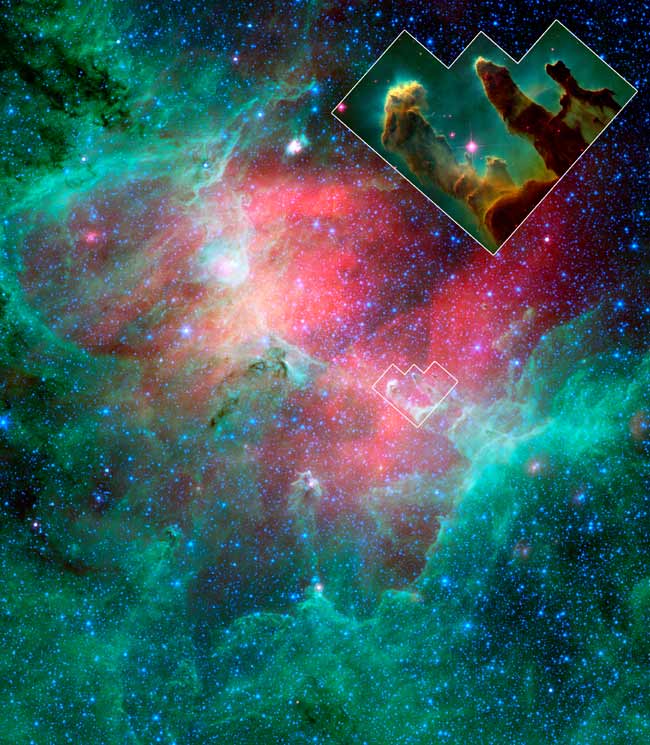
This story was updated at 2:50 pm EST.
SEATTLE - They helped open the public's eyes to the wonders of space when they were first photographed in 1995, but a new study suggests the famous Pillars of Creation in the Eagle Nebula might have already been toppled long ago, and that what the Hubble Space Telescope actually captured was only a ghost image.
A new picture of the Eagle Nebula shot by NASA's Spitzer Space Telescope, presented here at the 209th meeting of the American Astronomical Society, show the intact pillars next to a giant cloud of glowing dust scorched by the heat of a massive stellar explosion known as a supernova [image].
"The pillars have already been destroyed by the shockwave," said study leader Nicolas Flagey of The Institut d'Astrophysique Spatiale in France.
Astronomers think the supernova's shock wave knocked the pillars down about 6,000 years ago. But because the Eagle Nebula is located some 7,000 light years away, the majestic pillars will appear intact to observers on Earth for another 1,000 years or so.
The supernova blast is thought to have occurred between 6,000 and 9,000 years ago, so what astronomers see now is evidence of the blast just before its destructive shock wave reached the pillars.
Astronomers have long predicted that a supernova blast wave would destroy the famous pillars. One earlier study concluded that the pillars would be destroyed sometime within the next million years. About 20 stars in the region are ripe for exploding and it was only a matter of time before one detonated.
Get the Space.com Newsletter
Breaking space news, the latest updates on rocket launches, skywatching events and more!
The Eagle Nebula has been studied in infrared wavelengths before, but the new study is the most detailed yet. "What is brand new with Spitzer is that we have access to longer wavelengths," particularly the 70 micron wavelength, Flagey said. "We didn't have access to these wavelengths before."
The new Spitzer image suggests one of the stellar time bombs in the Eagle Nebula has already gone off. Humans living 1,000 to 2,000 years ago might have noticed the supernova event that destroyed the pillars as an unusually bright star in the sky.
"We have checked with historical records, and there might be some candidates," in Chinese history, Flagey said. It's also possible that the supernova was hidden behind huge amounts of interstellar dust that muffled the explosion, he added.
In an end befitting their name, astronomers think that gas and dust from the pillar's destruction will help give birth to a new generation of stars.
Editor's Note: All week, SPACE.com is providing complete coverage of the 209th meeting of the American Astronomical Society.
- IMAGES: Hubble's New Views of the Universe
- IMAGES: Hubble's New Era
- New Look at Fate of the Pillars of Creation
- Zoom Into the Eagle Nebula
- All About Nebulas
Join our Space Forums to keep talking space on the latest missions, night sky and more! And if you have a news tip, correction or comment, let us know at: community@space.com.
Ker Than is a science writer and children's book author who joined Space.com as a Staff Writer from 2005 to 2007. Ker covered astronomy and human spaceflight while at Space.com, including space shuttle launches, and has authored three science books for kids about earthquakes, stars and black holes. Ker's work has also appeared in National Geographic, Nature News, New Scientist and Sky & Telescope, among others. He earned a bachelor's degree in biology from UC Irvine and a master's degree in science journalism from New York University. Ker is currently the Director of Science Communications at Stanford University.









